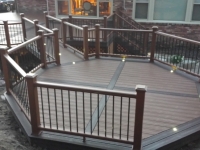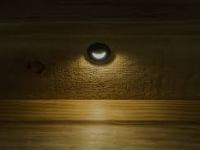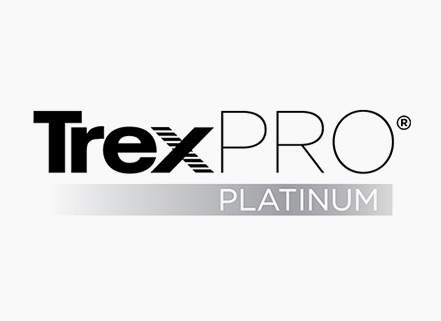The rules around deck stair lighting aren’t always super obvious, because “code” can depend a lot on which version of the building code your area has adopted — but there are some common requirements and good practices. Here’s a breakdown of what to know, plus some product ideas.
What the Building Codes Typically Require for Stair Lighting
Lighting Is Required on Exterior Stairs
- According to the IRC (International Residential Code), exterior stairways need an artificial light source.
- Specifically, many inspectors say that having a light near the top landing of the stairs can satisfy the requirement.
- NADRA (a decking association) notes that even if you use low-voltage step/riser lights, “at least one light fixture must be placed at the top landing.
Control Requirements
- The stairway light must be controllable from inside the house, per NADRA
- If the light isn’t switched inside, there’s an exception: it must be continuously illuminated (e.g., via a dusk-to-dawn timer or photo cell), or automatically (motion sensor).
Minimum Illumination Levels (Brightness)
- For egress stairs (i.e., stairs used to exit), codes like the IBC require 10 foot-candles (~108 lux) on the stair tread surfaces.
- Some lighting standards reference a lower “idle” or “background” level of illumination (like 1 foot-candle) when the stairs aren’t in active use.
- For residential stairs there needs to be at least 1 foot-candle of artificial light measured at the center of treads and landings.
Fixture Location / Type
- According to deck-lighting guides, many builders use low-voltage riser lights (mounted in the stair riser) or step/wall lights.
- When installing recessed stair/riser lights, you also need to make sure wiring is properly installed, and use a transformer if using low-voltage fixtures.
- The fixtures should be rated for outdoor use (damp or wet location, depending on exposure).
Why It’s Often Not Checked Very Strictly
- All deck inspections happen during the day, so stair lighting often isn’t tested or strictly enforced.
- Even if it’s required, local code officials might accept the light by the back door (if it sufficiently lights the top of the stairs) as satisfying code.
Local Code Matters
- Very important: local codes. Even if the IRC has a requirement, your city/county might have amended things. South Lyon, Michigan is a city that is very hard to pass code the first time. They will fail you for not having step lights.
- Always check with your local building department to confirm what’s required in your jurisdiction.
Most of our homeowners spend time on their decks in the evening, when the day’s work is done and it’s finally time to relax. Deck and landscape lights help extend that longed-for enjoyment time. When dusk arrives and the deck lights up, the atmosphere kicks up a notch with the right lighting in place. A low-voltage lighting system prolongs the time you spend outside by illuminating potential tripping hazards, adding character to your deck space, and creating a visual sense of warmth and excitement – even when viewed from the inside!
Trex Light Post LEDs

Trex offers a wide range of long-lasting LED low-voltage lights for deck and landscapes applications.
Michigan Cities wanting step lights for Code
- South Lyon
- Novi
- Washington Township
- Oakland Township
- Macomb Township
- Ann Arbor
- Dexter
- Livingston County












